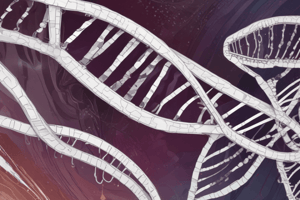Podcast
Questions and Answers
What is the karyotype associated with Klinefelter Syndrome?
What is the karyotype associated with Klinefelter Syndrome?
- 45, X
- 46, XY
- 46, XX
- 47, XXY (correct)
Which of the following clinical features is a characteristic of Turner Syndrome?
Which of the following clinical features is a characteristic of Turner Syndrome?
- Infertility
- Decreased libido
- Gynecomastia
- Short stature (correct)
What percentage of individuals with Turner Syndrome are expected to have significant cognitive delays?
What percentage of individuals with Turner Syndrome are expected to have significant cognitive delays?
- 50%
- 5%
- 10% (correct)
- 60%
In Klinefelter Syndrome, which of the following can occur in adult patients?
In Klinefelter Syndrome, which of the following can occur in adult patients?
What is a common reproductive concern for individuals with Turner Syndrome?
What is a common reproductive concern for individuals with Turner Syndrome?
Which type of chromosome abnormality is characteristic of Turner Syndrome?
Which type of chromosome abnormality is characteristic of Turner Syndrome?
Which feature distinguishes Klinefelter Syndrome from Turner Syndrome?
Which feature distinguishes Klinefelter Syndrome from Turner Syndrome?
Which of the following management strategies is recommended for patients with Klinefelter Syndrome?
Which of the following management strategies is recommended for patients with Klinefelter Syndrome?
What is the prevalence of Klinefelter Syndrome in male live births?
What is the prevalence of Klinefelter Syndrome in male live births?
Which feature is NOT commonly associated with Klinefelter Syndrome?
Which feature is NOT commonly associated with Klinefelter Syndrome?
What is the most common mechanism of aneuploidy?
What is the most common mechanism of aneuploidy?
Which chromosomal abnormality involves the addition of genetic material?
Which chromosomal abnormality involves the addition of genetic material?
What percentage of Trisomy 21 cases are attributed to non-disjunction?
What percentage of Trisomy 21 cases are attributed to non-disjunction?
Which feature is NOT commonly associated with Trisomy 18 (Edward's Syndrome)?
Which feature is NOT commonly associated with Trisomy 18 (Edward's Syndrome)?
In a balanced translocation carrier, what is expected regarding their offspring's genetic material?
In a balanced translocation carrier, what is expected regarding their offspring's genetic material?
What is the life expectancy for most newborns diagnosed with Trisomy 13 (Patau Syndrome)?
What is the life expectancy for most newborns diagnosed with Trisomy 13 (Patau Syndrome)?
Which of the following describes a characteristic feature of Down syndrome?
Which of the following describes a characteristic feature of Down syndrome?
Which chromosomal condition is characterized by a reduced total chromosome number due to the fusion of chromosome arms?
Which chromosomal condition is characterized by a reduced total chromosome number due to the fusion of chromosome arms?
Which of the following is a tertiary prevention strategy for aneuploidy?
Which of the following is a tertiary prevention strategy for aneuploidy?
What is the recurrence risk for females who are carriers of a balanced translocation?
What is the recurrence risk for females who are carriers of a balanced translocation?
Flashcards
Klinefelter Syndrome
Klinefelter Syndrome
A genetic condition in males characterized by an extra X chromosome (47,XXY).
Turner Syndrome
Turner Syndrome
A genetic condition in females characterized by the loss of an X chromosome (45,X).
Aneuploidy
Aneuploidy
An abnormal number of chromosomes.
Non-disjunction
Non-disjunction
Signup and view all the flashcards
Klinefelter karyotype
Klinefelter karyotype
Signup and view all the flashcards
Turner karyotype
Turner karyotype
Signup and view all the flashcards
Mosaicism
Mosaicism
Signup and view all the flashcards
Gynecomastia
Gynecomastia
Signup and view all the flashcards
Infertility
Infertility
Signup and view all the flashcards
Diagnosis of Sex Chromosome Abnormalities
Diagnosis of Sex Chromosome Abnormalities
Signup and view all the flashcards
Chromosome Deletion
Chromosome Deletion
Signup and view all the flashcards
Trisomy
Trisomy
Signup and view all the flashcards
Down Syndrome
Down Syndrome
Signup and view all the flashcards
Robertsonian translocation
Robertsonian translocation
Signup and view all the flashcards
Balanced translocation carrier
Balanced translocation carrier
Signup and view all the flashcards
Trisomy 13 (Patau Syndrome)
Trisomy 13 (Patau Syndrome)
Signup and view all the flashcards
Trisomy 18 (Edwards Syndrome)
Trisomy 18 (Edwards Syndrome)
Signup and view all the flashcards
Karyotyping
Karyotyping
Signup and view all the flashcards
Study Notes
Sex Chromosome Abnormalities
- Aneuplodies of X or Y chromosomes produce less severe phenotype compared to those with autosomal aneuplodies
- More compatible with life than autosomal aneuplodies
- Result from non-disjunction during meiosis (maternal & paternal)
Klinefelter Syndrome
- Prevalence: 1 in 600-800 male live births
- Karyotypes:
- 47, XXY
- 48, XXXY, 49, XXXXY
- 46, XYY, 47, XXY (mosaic)
- Prenatal features:
- Often normal
- Pubertal features:
- Average to tall height (long legs)
- Mild, often normal
- Adult features:
- Gynecomastia, small/firm testes
- Infertile, decreased libido, reduced beard growth, osteoporosis, muscle weakness, thromboembolic disease, obesity, diabetes
Turner Syndrome
- Prevalence: 1 in 2500-3000 live female births
- Karyotype:
- 45, X
- 45, X, Xq (mosaicism)
- 46, X, Xq (isochromosome)
- Prenatal features:
- Increased nuchal translucency/edema
- Puffy dorsum of hands & feet
- Nuchal skin fold / webbed neck
- Cardiac abnormalities
- Postnatal features:
- Short stature (average 145cm)
- Cardiovascular (coarctation of aorta, bicuspid aortic valve, VSD)
- Conductive defects, hypertension
- Renal abnormalities (kidney agenesis)
- Skeletal abnormalities (increased carrying angle, CDH, scoliosis)
- Other:
- Delayed puberty
- Endocrine complications (obesity, hypothyroidism)
- Deafness, recurrent otitis media
- Squints, cataracts, nystagmus
- Cognitive:
- 10% are significantly delayed (all karyotypes)
- 70% will have visual spatial problems, problems with maths, driving, social function
Studying That Suits You
Use AI to generate personalized quizzes and flashcards to suit your learning preferences.




